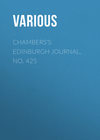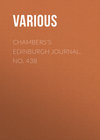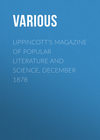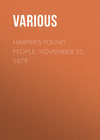Kitabı oku: «Blackwood's Edinburgh Magazine. Volume 55, No. 343, May 1844», sayfa 9
Other anecdotes were recounted during our ride, and our opinion of his Hellenic majesty’s tact and taste did not become more favourable, when it was discovered that his proceedings had utterly ruined the immense quarries of Pentelicus—
“Still in its beam Pentele’s marbles glow,”
can now only be said of the ruins, not of the quarries. In order to obtain the few thousand blocks required for the royal palace at Athens, millions of square feet of the purest statuary marble have been shivered to atoms by the random process of springing mines with gunpowder. If King Otho had done nothing worse in Greece than converting the marble quarries of Pentelicus into a chaos of rubbish, when he found them capable of supplying all Europe for ages with the most beautiful material for the sculptor, he would have merited the reputation he so justly bears, of caring as little about the real welfare of Greece as Lord Palmerston himself. My companions quitted me at the quarries, making pasquinades on the royal palace and its royal master; while I put up my horse and walked slowly on to the ancient monastery of Pentele, not Mendele, as Lord Byron has it.
I was soon sitting alone in the cell of Michael, and shall now recount his history as I had it from his own mouth. Michael Kalliphournas was left an orphan the year the Greek revolution broke out. He was hardly fourteen years old, and yet he had to act as the guardian and protector of a sister four years younger than himself. The storm of war soon compelled him to fly to Ægina with the little Euphrosyne. The trinkets and gold which his relations had taught him to conceal, enabled him to place his sister in a Catholic monastery at Naxos, where she received the education of a European lady. Michael himself served under Colonel Gordon and General Fabvier with great distinction. In 1831, when the Turks were about to cede Attica to Greece, Michael and Euphrosyne returned to Athens, to take possession of their family property, which promised to become of very great value. At that time I had very often seen Phróssa, as she was generally called; indeed, from my intimacy with her brother, I was a constant visitor in the house. Her appearance is deeply impressed on my memory. I have rarely beheld greater beauty, never a more elegant figure, nor a more graceful and dignified manner. She was regarded as a fortune, and began to be sought in marriage by all the young aristocracy of Greece. It was at last conjectured that a young Athenian, named Nerio, the last descendant of the Frank dukes of Athens, had made some impression on her heart. He was a gay and spirited young man, who had behaved very bravely when shut up with the troops in the Acropolis during the last siege of Athens, and he was an intimate friend of her brother. I had left Athens about this time, and my travels in the East had prevented my hearing any thing of my friends in Greece for years.
There is a good deal of society among the Greek families at Athens for a few weeks before the Carnival. They meet together in the evenings, and amuse themselves in a very agreeable way. At one of these parties the discourse fell on the existence of ghosts and spirits; Michael, who was present, declared that he had no faith in their existence. With what groans did he assure me his opinion was changed, and conjured me never to express a doubt on the subject. All the party present exclaimed against what they called his free-masonry; and even his sister, who was not given to superstition, begged him to be silent lest he should offend the neraiïdhes, who might punish him when he least expected it. He laughed and ridiculed Phróssa, offering to do any thing to dare those redoubted spirits which the company could suggest. Nerio, a far greater sceptic than Michael, suddenly affected great respect for the invisible world, and by exciting Michael, gradually engaged him, amidst the laughing of his companions, to undertake to fry a dozen of eggs on the tomb of a Turkish santon, a short distance beyond the Patissia gate—to leave a pot of charcoal, to be seen next morning, as a proof of his valour, and return to the party with the dish of eggs.
The expedition was arranged, in spite of the opposition of the ladies; four or five of the young men promised to follow at a little distance, unknown to Michael, to be ready lest any thing should happen. Michael himself, with a zembil containing a pot of charcoal, a few eggs and a flask of oil in one hand, and a frying-pan and small lantern in the other, closely enveloped in his dusky capote, proceeded smiling to his task. The tomb of the Turk consisted of a marble cover taken from some ancient sarcophagus, and sustained at the corners by four small pillars of masonry—the top was not higher than an ordinary table, and below the marble slab there was an empty space between the columns. It has long since disappeared; but that is not wonderful, since King Otho and his subjects have contrived to destroy almost every picturesque monument of the past in the new kingdom. The thousands of Turkish tombs which not many years ago gave a historic character to the desert environs of Negrepont, and the splendid sérail of Zeitouni, with its magnificent marble fountains and baths, have almost disappeared—the storks have bid adieu to Greece—nightly bonfires, caused by absurd laws, destroy the few trees that remain; and in short, unless travellers make haste and visit Greece quickly, they will see nothing but the ruins which King Otho cannot destroy nor Pittaki deface, and the curiosities which Ross cannot give to Prince Pückler, added to the pleasure they will derive from beholding King Otho’s own face and the façade of his new palace.
The night was extremely dark and cold, so that the friends of Michael, familiar as they were with their native city, found some difficulty in following him without a lantern through the mass of ruins Athens then presented. As they approached the tomb, they perceived that he had already lighted his charcoal, and was engaged in blowing it vigorously, as much to warm his hands as to prepare for his cooking operations. Creeping as near to him as possible without risking a discovery, they heard, to their amazement, a deep voice apparently proceeding from the tomb, which exclaimed, “Bou gedje kek sohuk der adamlera.—It must be a cold night for mankind.” “To pisevo effendi,” said Michael in a careless tone, but nervously proceeded to pour a whole bottle of oil into the frying-pan. As soon as the oil was boiling and bubbling, the voice from the tomb again exclaimed, “Gaiour ne apayorsun, mangama pisheriorsun—yuckle buradam—aiyer yiklemassun ben seni kibab ederem, tahamun yerine seni yerim,” signifying pretty nearly, “Infidel, what are you doing here? You appear to be cooking; fly hence, or I will eat my supper of thy carrion.” And at the instant a head covered by an enormous white turban protruded itself from under the tombstone with open mouth. Michael, either alarmed at the words and the apparition, or angry at the suspicion of a premeditated trick on the part of his companions, seized the panful of boiling oil, and poured the whole contents into the gaping mouth of the spectre, exclaiming, “An echeis toson orexin, na to ladhi, Scheitan oglou!—If you are so hungry, take the oil, son of Satan!” A shriek which might have awakened the dead proceeded from the figure, followed by a succession of hideous groans. The friends of Michael rushed forward, but the lamp had fallen to the ground and was extinguished in the confusion. Some time elapsed ere it was found and lighted. The unfortunate figure was dragged from the tomb, suffocated by the oil, and evidently in a dying state, if indeed life was not already extinct. Slowly the horrible truth became apparent. Nerio had separated himself from the rest of the party unperceived, disguised himself, and gained the tomb before the arrival of Michael, who thus became the murderer of his sister’s lover. I shall not attempt to describe the feelings of Michael in recounting this dreadful scene.
The affair never made much noise. The Turks did not consider themselves authorized to meddle in the affairs of the Greeks. Indeed, the infamous murder of the Greek bakalbashi, a short time before by Jussuf-bey, with his own hand, had so compromised their authority, that they were in fear of a revolution. The truth was slowly communicated to Euphrosyne by Michael himself—she bore it better than he had anticipated. She consoled her brother and herself by devoting her life to religious and charitable exercises; but she never entered a monastery nor publicly took the veil. She still lives at Athens, where her charity is experienced by many, though few ever see her. When I left Greece on a visit to Mount Athos, my friend Michael insisted on accompanying me; and, after our arrival on the holy mountain, he exacted from me a promise that I would never discover to any one the monastery into which he had retired, nor even should we by chance meet again, address him as an acquaintance, unless he should speak to me. His sister alone is entrusted with his secret.
AFRICA—SLAVE TRADE—TROPICAL COLONIES

The readers of this magazine will readily remember the part which it took, at an early period, in discussing and in delineating the geographical features of Africa. In the number for June 1826 there is an article, accompanied by a map, showing from undoubted authorities the course and termination of the great river Niger in the sea in the Bight of Benin, where, from similar authorities, it was placed by me in 1820 and 1821, and where actual observation by Englishmen has lately clearly established the fact that it does terminate. In the upper and middle parts of its course the longitudes were erroneous, having adopted Major Rennell’s delineation of Western Africa as a guide; but in 1839 the whole of that quarter of Africa was narrowly examined, and the courses of the western rivers reduced to their proper positions, as delineated in my large map of Africa constructed in that year, to which, with the “Geographical Survey of Africa,” for which it was made, the reader is referred for further and particular information on all these subjects.
With these observations, I proceed to bring before the reader geographical information concerning eastern and central Africa of the highest and most gratifying importance, and obtained by the researches of different voyagers and travellers within the last four years. Foremost amongst these ranks, the expedition sent by the present Viceroy of Egypt to explore the Bahr-el-Abiad, or White River, above its junction with the Blue River, from Khartoum upwards and southwards; after it, the interesting travels of Messrs Krapf and Isenberg, two missionaries from the Church Missionary Society, from Tajura to Ankobar, from Ankobar south-west to the neighbourhood of the sources of the Hawash; and after that, Mr Krapf’s journey from Ankobar north by Lake Haik, through Lasta to Antalow, and thence to Massouah on the Red Sea. Next, the interesting accounts collected by M. Lefebvre and M. D’Abbadie, concerning the countries in some parts of the more eastern horn of Africa; and last, and the most specific and important of the whole, the accounts received of the country of Adel, and the countries and rivers in and south of Shoa, and those from the Blue Nile in Gojam and Damot to the sea at the mouth of the Jub, under the equator, by Major Harris, late British ambassador to the King of Shoa.
As the present article is accompanied by a map, constructed after great labour, and engraved most carefully by Mr Arrowsmith, the general outline of the whole may here be deemed sufficient, without lengthened discussion and observation.
The Egyptian expedition alluded to started from Khartoum (now become a fine town) at the close of the wet season in 1839. It consisted of four or five small sailing vessels, some passage boats, and four hundred men from the garrison of Senaar, the whole commanded by an able officer, Captain Selim. They completed their undertaking, and returned to Khartoum at the end of 135 days, during which time, in obedience to the commands of their master, they explored the Bahr-el-Abiad to the distance southwards of 1300 miles, (turnings and windings included,) to three degrees thirty minutes north latitude, and thirty-one east longitude, from Greenwich, where it divided into two streams; the smaller, and it is very small, coming from the south-west, and the larger, still even at the close of the dry season a very considerable river, which came from the south-east, upwards from the east, and still more upwards from the north-east. A subsequent voyage in 1841 gained the information that the stream descended past Barry, and there can be no doubt that another, if not the chief branch, comes from the south-east, in the bearing which Ptolemy gave it, and, as he states, from amongst mountains covered with perpetual snow, of which Bruce also heard, and which we now learn from Major Harris really stand in that quarter of Africa.
The longitude of the river at the bifurcation is exactly the same as Ptolemy has given it, which is very remarkable. The sources of the White River will therefore be found where Ptolemy and Bruce have placed them. The latter, in his notes, states expressly that the Bahr-el-Abiad rose to the south of Enarea, not far from the equator, and that it had no great western branch, nor was any necessary to give the river its magnitude. (Vol. vii. App. p. 92.)
The expedition in question found no very large affluents from the west side; but they found two of very considerable magnitude on the east side—one the Blue River, and the other the Red River, or Bahr-Seboth, which latter they navigated upwards of 150 miles in a direct line, and left it a considerable stream, nearly as large as the eastern branch of the White River, where they had left it. The banks of the Bahr-Seboth were precipitous and high, whereas those of the Bahr-el-Abiad were low, and on both sides covered with lakes, the remains probably of the preceding inundation. Scarcely a hill or mountain was in sight from the river till approaching the bifurcation, when the country became mountainous, the climate more cool, and the vegetation and trees around those of the temperate zone. The country on both sides is a high table-land, the scenery every where very beautiful, well peopled by different tribes, copper-coloured, and some of them even fair. Every where the banks are covered and ornamented with beautiful trees, and cattle, sheep, goats, elephants, &c., are numerous and abundant. Amongst the Bhours, they found Indian goods brought from the shores of the Indian ocean. Day by day, the breadth, depth, and current of the river were observed and marked. For a considerable distance above Khartoum, the breadth was from one and a half to one and a quarter mile, the depth three or four fathoms, and the current about one and a half mile per hour. Above the parallel of nine degrees, the river takes a remarkable bend due west for about 90 miles, when it passes through a large lake, the waters of which emitted an offensive smell, which might proceed from marshy shores.28 Above the lake, the breadth decreases to one-third or one-fourth of a mile, the depth to twelve or thirteen feet, with a current of one and a half mile per hour, the bottom every where sand, with numerous islands interspersed in the stream. The mountainous country around the upper part abounds with iron mines.
Going eastward, we come to the elevated mountainous ranges which give birth to the Bahr-el-Abiad to the south, the Gochob, the Kibbee, and their numerous tributary streams to the east and south-east, and the Toumat, the Yabous, the Maleg, and other rivers which flow north into the Abay. This vast chain is very elevated, and in many places very cold, especially to the west of Enarea, and to the west and south of Kaffa. From the sources of the Kibbee and the Yabous, it stretches eastwards to Gurague, and thence, still eastward, by the Aroosi, Galla, and Hurrur or Harrar, to Cape Guardafui, approaching in some places to within sixty miles or less of the sea of Babel-Mandeb; the elevation to the east of Berbera decreases to about 5000 feet, and from which numerous streams flow both to the north and to the south. Eastward of the meridian of Gurague, a branch from the chain strikes off due north through Shoa, by Ankobar and Lake Haik, to the northward of which it separates, and runs one branch N.N.W. to Samen, and another by Angot, N.E. by east, to the Red Sea, at Assab, and the entrance of the straits of Babel-mandeb. The whole of this chain is very elevated; near Ankobar some peaks being 14,000 feet high, and constantly white with snow or hail; and round the sources of the Tacazzè and the Bashilo, near the territory of the Edjow Galla, the mountains are covered with snow. Mr Krapf, in his journey more to the east, found the cold exceedingly keen, the elevation exceeding 10,000 feet; and still more eastward, near the little Assanghe lake, Pearce found hoar frost in the mornings in the month of October. From the ranges mentioned, numerous other ranges branch off in different directions, forming the divisions between tribes and rivers, the latter of which are very rapid, and their borders or banks very high and precipitous, and rugged.
From the province of Bulga or Fattygar, this chain, running northwards, rises to a great height, springing like the walls of a fortification from the western bank of the Hawash, from whence numerous small streams descend to increase that river. All to the eastward of that river is comparatively low, (called Kôlla, or the low hot country,) and to the sea-shore is one continued sheet of volcanic strata and extinct volcanoes, dry and poor, especially during the dry season, when travelling is difficult and dangerous owing to the want of water. It is inhabited chiefly by wild beasts and by fierce tribes of the wandering Dancali, and, more to the south-east, by the Mohammedan Somauli. In early times this country, however, was rich and powerful, from being the channel of commerce between Abyssinia when powerful, and the countries to the east, Arabia, Persia, and India. From Zeila and Erur southward, the country improves, and becomes fertile and well watered.
Before turning our attention to the interesting countries round the sources of the Gochob and its tributary streams, and those through which it subsequently flows, so clearly brought to our knowledge by Major Harris, (he is certainly the first who has done so,) and the survey of the coast near its mouth by Lieutenant Christopher of the Indian navy, and by him given to the gallant major—it is necessary, for the better understanding of our subject, to turn our attention to the explanation of the names of some countries and places given so differently by different informants, and which, thus given and not sufficiently attended to, create great confusion and great errors in African geography.
By the aid of Mr Bruce, Mr Krapf, Major Harris, and information collected from native travellers, (see Geographical Bulletins of Paris, Nos. 78 and 98,) we are enabled to rectify these points, and clear away heaps of inaccuracies and confusion.
First, then, Enarea and Limmu are the same. The country is called Enarea by the Abyssinians, and Limmu by the Gallas, having been conquered by a Galla tribe of that name, which tribe came originally from the south-west. There is another Limmu, probably so named from another portion of the same tribe. It is near or the same as Sibou, which, according to Bruce, is ten days’ journey from the capital of Enarea, and, according to the French Geographical Bulletin, (No. 114,) not far from Horro and Fazoglo. But the first Limmu is the Limmu of Jomard’s Galla Oware, because he states distinctly that Sobitche was its capital; that, in marching northwards from it, he crossed the Wouelmae river; and that Gingiro, to which he had been, lay to the right, or east, of his early route; and further, that the river which passed near Sobitche ran to the south. Enarea is not very extensive, but a high table-land, on every side surrounded by high mountain ranges, and is situated (see Geographical Bulletin, 1839) at the confluence of two rivers, the Gibe and the Dibe.
Kaffa, in its restricted sense, is a state on the upper Gochob; but, in its ancient and extended meaning, it is a large country, extending from north to south a journey of one month, and includes in it several states known by separate names, although the whole of these are often referred to in the name Kaffa by native travellers. It is known also by the names of Sidama and Susa, and the people of Dauro call it Gomara; but the Christians in Southern Abyssinia call it Kaffa, and Sidama or Susa, which latter, properly speaking, forms its southern parts.
Dawro, Dauro, or Woreta, are the same; it is a large country, and divided into three states—namely, Metzo or Metcho, Kulloo, and Goba; and is a low and hot, but fertile country, situated to the east of Kaffa, and to the west of the Gochob.
Major Harris is the only individual who has given us the bearings and distances connected with this portion of Africa, and without which the geographical features of the country could not have been fixed with any precision; but which, having been obtained, act as pivots from which the correct positions of other places are ascertained and fixed with considerable accuracy.
Let us now attend to the sources and the courses of the principal rivers. The Kibbee, or Gibe, has three sources. The chief branch springs to the west of Ligamara, and southwards of that place it runs east, (Geographical Bulletin, No. 105, and also No. 78,) when suddenly turning upon itself; as it were, it bends its course westward to Limmu, having below Leka received the Gwadab, coming from the west and passing to the south of Lofe. The Kibbee waters the small but elevated country of Nono, and passes very near Sakka. Westward of Sakka it is joined by two other branches coming from the north-west and west, one called Wouelmae, the Wouelmae of Oware, and the other Dibe. From thence it flows eastward, and bounds Gingiro on the north. The early Portuguese travellers expressly state, that six days’ journey due east from Sakka, and at one day’s journey from the capital of Gingiro, having first crossed a very high mountain, they crossed the Kibbee, a rapid rocky stream, and as large as the Blue River where they had crossed it in the country of the Gongas. On the third day after leaving the capital of Gingiro, pursuing their course due east to the capital of Cambat, they again crossed the Zebee, or Kibbee, larger than it was to the westward of Gingiro, but less rapid and rocky; its waters resembling melted butter, (hence its name,) owing, no doubt, to the calcareous ridges through which it flowed. From thence it bends its course to the southward, and is soon after joined by the Gochob, which bounds the empire of Gingiro to the south. Bruce particularly and emphatically mentions the extraordinary angle which the Kibbee here makes.
To the north of Gingiro the Kibbee is joined by the Dedhasa, (pronounced Nassal,) and which is considered to be the same as Daneza or Danesa, which, according to Lieutenant Christopher, is a Galla name for the Jub or Gochob. This river is passed (see Geographical Bulletin of 1839) before coming to Ligamara and Chelea, and one and a half day’s journey from Gouma, in the route from Gooderoo to Enarea. In its lower course it abounds with crocodiles. Below the junction with the Dedhasa, the Kibbee receives the Gala river, coming from the north-east, and from the confines of Gurague and Kortshassie.
The separation of the waters in these parts takes place to the north of Gonea and Djimma, or Gouma. The rivers that flow to the Blue Nile or Abay, with the exception of the Yabous, which is, according to Bruce, a considerable stream descending from the south and south-east, are all small streams. Shat, the province where the tea-plant is produced, is situated to the north of Enarea, and is watered by the river called Giba, the fish of which are said to be poisonous, (Bruce, vol. iii. p. 254.) Bruce states most pointedly that the capital of Enarea is fifty leagues distant from the passage of the Abay at Mine, “due south, a little inclining to the west,” (Vol. iii. page 324;) and which bearing and distance corresponds very correctly with several very clear and satisfactory itineraries lately obtained. Without any high peaks or mountains, the country round the sources of these rivers is very elevated, and from the grain and fruits which they produce, cannot be less than 7500 feet above the level of the sea.
The Toumat is a small stream. Above Cassan, says the Geographical Bulletin, No. 110, it has water all the year, thus indicating that below that place the water fails in the dry season. It runs between two high chains of mountains; the east Bank, that chain being known as the country called Bertat. The rains, according to Bruce, (the Geographical Bulletin agrees in this,) commence in April; but they do not fall heavy at that time, and but little affect the rivers. Beyond the chain, on the western bank of the Toumat, the country is level to Denka and the banks of the White River, which is stated to be eleven days’ journey due west from Fazoglo. Iron is very abundant in the countries round the Toumat and the Yabous, and caravans of Arabian merchants regularly traverse the country from Ganjar near Kuara, and two days’ journey south of Kas-el-Fael, by Fazoglo and Fadessi, to Kaffa and Bany; the road, as the latter places are approached, being described as hilly and very woody, with numerous small streams.
The Gochob rises in Gamvou, a high, wild, and woody country, part of Limmu; and bending its course south-east, next east, and then south-east, it forms the lake Tchocha, and afterwards rolls over the great cataract Dumbaro, soon after which it joins the Kibbee, when the united stream tales the name of the Gochob, or Jub, by which it is known till it enters the sea. Where crossed in the road from Sakka to Bonga, it is described as larger than any other stream which flows to join it from the country more to the south; much larger, indeed, than either the Gitche or Omo, its subsequent tributaries. These are the principal rivers of Kaffa, which is described as a high, cold country, as cold as Samen, or Simien, as Major Harris writes it, in Abyssinia. Bonga, the capital of Kaffa, or Susa, is one of the largest cities in these parts, and coffee of superior quality is produced every where, both in Kaffa and Enarea, in the greatest abundance. So also is civet and ivory.
The Omo, where crossed in the road to Tuftee, is passed by a bridge of wood sixty yards in length, which shows that it is not a very large river, nor can it be, this place being so near the district where its sources must lie. In the dry season it is described as a very small stream. The mountains in the south of Kaffa or Susa, are covered with snow, and to the south of this place they are said to rise to a stupendous height, “to reach the skies,” and are clothed with eternal snow!
Malo, or Malee, (as Major Harris spells it,) is westward from Koocha, and not far from Jajo, (certainly the Jedo of Salt,) and which is at a considerable distance from the sea, (Geographical Bulletin, No. 114.) Malee touches upon both Goba and Doko, and the latter again touches upon Kulloo. It is in Malee that the Omo, now a considerable stream, joins the Gochob, after having received from the mountains of Souro and valleys of Sasa the Toreesh or Gotze, a considerable stream. Doko and Malee, like Dauro or Woreta, are very hot low countries, abounding in cotton. In Doko, bamboo forests are frequent and extensive. The population are represented to be of a diminutive stature, exceedingly rude and ignorant, and are a prey to all their surrounding neighbours, who invade their country at pleasure, and carry off the wretched people into slavery. In this portion of Africa, or very near it, the early Arab writers and Portuguese navigators placed a nation of pigmies; and in this it would appear that they were correct. After the junction of the Omo, the Gochob pursues its way by Ganana to the sea at Juba, a few miles to the south of the equator. The western bank is inhabited by Galla tribes, and the eastern by Somauli. In this part of its course it is called Jub by the Arabians, Gowend or Govend by the Somauli, Yumbu by the Souahilis, and Danesa by the Gallas.
The Gochob below Wolama is joined on the east side by a considerable stream called the Una, which rises to the south of Gurague; and in Koocha and on the same side by a still larger stream, which comes from the country of the Ara or Ala Galla to the east of Gurague, and near the western sources of the Wabbe or Webbe. Koocha is thirty days’ navigation upwards and fifteen downwards from the sea, with which it has a considerable trade; white or fair people coming up the river to that place; but these are not allowed to proceed further inland. The inhabitants of Koocha carry on a great trade by means of the Gochob with Dauro in slaves, ivory, coffee, &c.; the Galla of Dauro bringing these down the Gochob in rafts with high gunwales, which indicates that the Gochob is a river of considerable magnitude, and may become of great importance in the future communications with Africa; the soil and climate around it being very fine, particularly in the lower parts near the sea, where the land is level, and the soil a fine deep red mould.
After Bruce, Salt had delineated with considerable accuracy the source of the Webbe and the countries around it; but, except his map, we had no further particulars. These are, however, supplied by Major Harris and Mr Krapf in the countries south-east of Shoa, about Harrar and its sources; and further by accounts collected by D’Abbadie at Berbera from intelligent natives, travellers regarding the countries more to the south, and over the remainder of the north-eastern coast of Africa.










